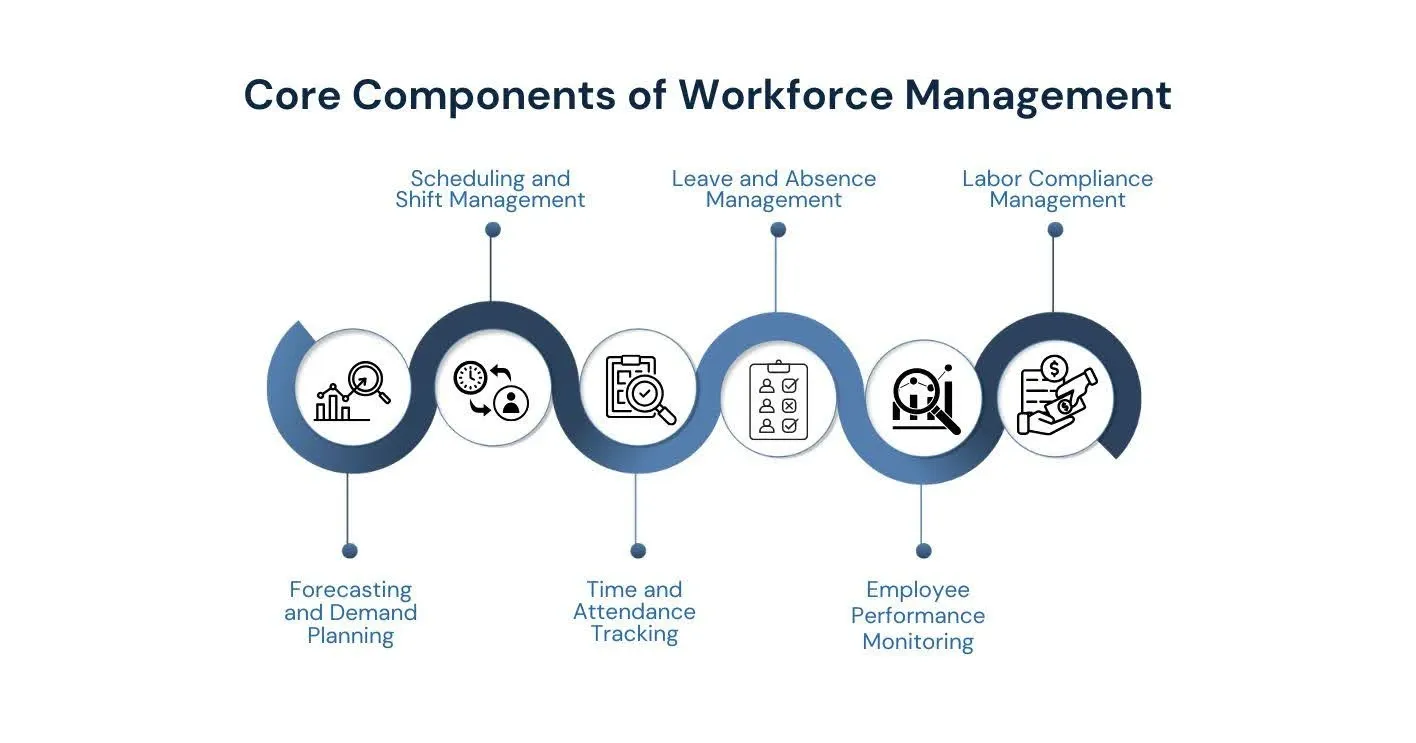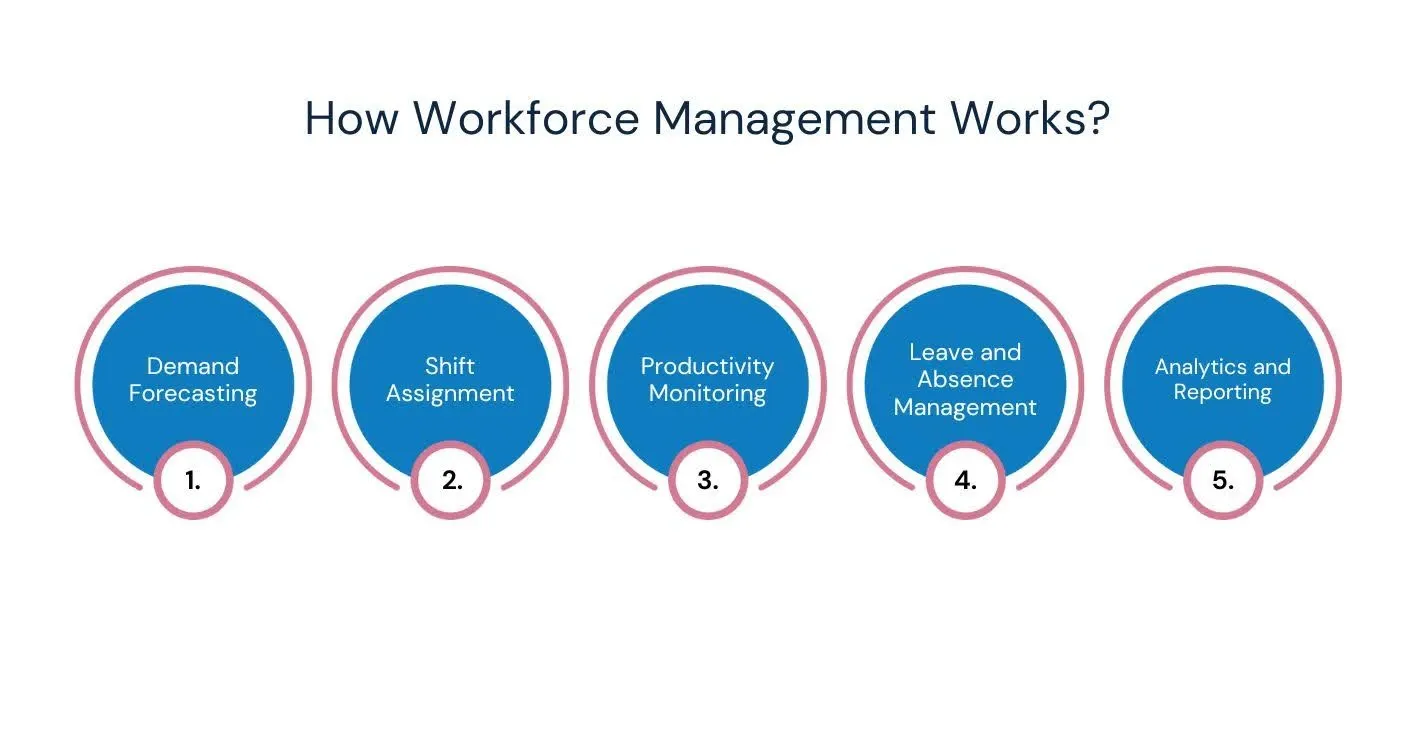
Managing your workforce effectively is one of the toughest challenges businesses face today. Without the right systems in place, scheduling conflicts, labor shortages, and compliance issues can quickly drain productivity and increase costs. Workforce management (WFM) provides a structured approach to tackle these problems by optimizing how employees are scheduled, tracked, and managed.
In this complete guide, you will learn what workforce management entails, why it’s essential for business success, and how adopting the right strategies and tools can transform your operations.
Workforce Management (WFM) refers to the strategies and processes that organizations use to ensure the right people are working at the right time and in the right place to meet business goals. It involves forecasting labor needs, creating schedules, tracking attendance, and managing compliance with labor laws and company policies.
The goal of Workforce Management is to optimize employee productivity while controlling labor costs and maintaining high service levels. This requires balancing business demand with employee availability, skills, and preferences.
Now that we understand what workforce management entails, it's important to explore why it plays such a vital role in the success of an organization.
Suggested Read: Understanding What 75th Percentile Means in Salary Compensation
Effective workforce management ensures you have the right number of skilled employees scheduled at the right times to meet business demands. It reduces labor costs by minimizing overtime and overstaffing, while improving service quality and customer satisfaction.
WFM also helps maintain compliance with labor laws and supports employee well-being through fair scheduling, ultimately driving operational efficiency and sustained organizational success.
Key Reasons Workforce Management Matters:
Workforce management is a cornerstone of efficient operations, directly influencing costs, service quality, and employee morale. Proper management helps prevent costly staffing errors, reduces legal risks, and fosters a motivated workforce.
Organizations can position themselves to respond agilely to changing business environments and maintain a competitive advantage over the long term by prioritizing workforce management.
Now that we have covered the importance of workforce management, it's important to consider who can truly benefit from its implementation.
Suggested Read: What is Merit Pay And How Does It Impact Salary Increases?
Workforce management is essential for organizations of all sizes and industries, but its importance grows with operational complexity. Businesses with hourly workers, shift-based schedules, or fluctuating demand benefit significantly from WFM systems.
Industries That Benefit Most:
Company Sizes:
As work models evolve, adopting workforce management practices becomes essential to maintain productivity and engagement in today’s diverse and dynamic environments.
To truly grasp the power of workforce management, it's important to break it down into its core components. This is discussed in the next section.
Suggested Watch: Watch the video to see how workforce management can benefit your customer service teams and business.

Effective workforce management relies on several key components that work together to ensure operational efficiency and employee satisfaction. These elements encompass everything from forecasting labor needs to tracking attendance and managing compliance.
Understanding these core areas enables organizations to build a strong foundation for balancing business demand with workforce capacity. Workforce management can enhance productivity and ensure regulatory compliance.
Forecasting uses historical data, business trends, seasonality, and market analysis to predict future staffing requirements. Accurate demand planning helps avoid costly mistakes like understaffing, which can lead to poor customer service, or overstaffing, which inflates labor costs.
Advanced forecasting tools consider multiple variables and can adjust predictions in real-time based on new data, ensuring responsiveness to changing conditions.
Scheduling assigns employees to shifts in a way that maximizes coverage while respecting labor laws, employee availability, skills, and preferences. Effective shift management balances operational needs with employee work-life balance, minimizing conflicts and reducing absenteeism.
Dynamic scheduling software can accommodate last-minute changes and automate shift swaps, making the process more efficient and flexible.
This component records when employees clock in and out, tracks break times, and logs absences. Precise timekeeping is essential for accurate payroll processing and helps ensure compliance with labor regulations such as overtime rules.
Integration with biometric systems or mobile apps can improve accuracy and reduce time theft or buddy punching. Real-time attendance monitoring also helps managers identify patterns and address issues proactively.
Leave management oversees employee vacations, sick days, family leave, and other absences, ensuring proper staffing levels are maintained. Automated leave tracking simplifies requests and approvals, maintains accurate balance records, and enforces company policies.
Proactive absence management can identify trends like frequent sick days, allowing HR to address potential issues before they affect productivity.
Monitoring employee performance involves collecting and analyzing data on productivity, quality, attendance, and other key indicators.
This information helps managers recognize high performers, identify skill gaps, and provide targeted training or coaching. Performance metrics can be linked to scheduling and workload management to optimize team effectiveness and support career development.
Compliance management ensures adherence to labor laws, union contracts, and company policies related to working hours, overtime, breaks, and workplace safety.
Automated alerts and audit trails reduce the risk of violations and associated penalties. Keeping compliance integrated with scheduling and time tracking prevents costly mistakes and supports transparent labor practices.
Having explored the core components of workforce management, it's time to look at the many benefits it offers.
Suggested Read: Understanding What Competitive Salary Means
Workforce management offers critical advantages by optimizing how you schedule, track, and engage your employees. These benefits collectively support smoother operations, better decision-making, and a more resilient organization able to adapt to changing business needs.
The benefits of workforce management extend beyond immediate operational improvements. By reducing costs, boosting productivity, and promoting employee well-being, WFM lays the foundation for sustainable growth.
In the next section, we will explore how workforce planning actually works.

From the Community: Read this thread to understand how workforce management improves employee efficiency.

Workforce management combines data collection, automated scheduling, real-time monitoring, and analytics to align employee availability with business demand. This systematic approach enables organizations to optimize staffing, maintain compliance, and respond promptly to changing conditions.
Workforce management ensures your labor resources align with business needs through a series of coordinated steps involving data, automation, and analysis.
Forecasting starts by gathering data like past sales and staffing patterns. Advanced analytics then predict when and how many employees you will need, helping you avoid costly understaffing or overstaffing situations.
Scheduling is a strategic process that begins with generating shifts based on forecasted demand. It takes into account employee skills, availability, and compliance with labor laws to assign shifts in a way that is both efficient and fair. The schedule is designed to create balanced shifts that align with employee preferences.
With the help of digital tools, employee clock-ins and work hours are tracked in real-time, allowing managers to monitor attendance seamlessly. This real-time tracking enables quick identification of any absences or performance issues. Productivity monitoring allows managers to respond swiftly to any unexpected disruptions.
Leave management systems automate the process of tracking employee time off and handling leave requests, streamlining approvals and ensuring that staffing levels remain adequate even during absences. This automated approach helps maintain compliance with company policies and labor laws while preventing staffing gaps that could disrupt operations.
Generating detailed reports on labor costs, compliance, and productivity provides valuable insights into workforce performance. These analytics offer a clear view of key metrics, enabling managers to make data-driven decisions that optimize workforce planning.
Now that we have covered the way workforce management works, let's take a look at some real-world examples.
Workforce management is a critical aspect of modern business operations, helping organizations refine their processes. Here are several key examples of how workforce management solutions are transforming industries.
With so many workforce management solutions available today, selecting the right software can be a daunting task. To help simplify this process, let’s explore the key factors you should consider.
Selecting the right workforce management software is necessary for enhancing employee performance and overall business efficiency. Here are the key factors to consider when selecting the best software for your organization:
By carefully evaluating these factors, you can choose the workforce management software that best fits your business's needs. Now, let’s take a look at some of the common obstacles businesses face and how to overcome them.
Workforce management involves juggling many moving parts, and organizations often face obstacles that can hinder effectiveness. These are a few common challenges that organizations face:
Rapid and unexpected changes in customer demand or business volume make it difficult to forecast staffing needs accurately, risking either understaffing or excessive labor costs.
Solution: Businesses can implement predictive analytics that employ historical data and trends to forecast future needs more accurately. Additionally, adopting flexible staffing models and part-time workers can help you adjust more easily to changes in demand.
Coordinating shifts that accommodate varying employee skills, availability, legal restrictions, and preferences creates a complicated scheduling puzzle that can lead to conflicts and inefficiencies.
Solution: Workforce management software with automated scheduling tools can simplify this process by factoring in employee skills, availability, and legal requirements.
Disparate systems or manual data entry increase the risk of errors in time tracking, payroll, and compliance reporting, undermining trust in workforce data.
Solution: Implementing a unified workforce management platform that integrates easily with existing HR, payroll, and project management systems can eliminate data silos and reduce errors.
Navigating diverse and evolving labor laws, including overtime, breaks, and union rules, requires constant vigilance to avoid costly violations and penalties.
Solution: To stay compliant, businesses should invest in workforce management software that regularly updates labor law changes and automatically adjusts schedules and pay calculations to meet legal requirements.
Without proper training and communication, employees may resist new WFM tools or processes, limiting the system’s effectiveness and ROI.
Solution: Engaging employees early in the implementation process, providing thorough training, and highlighting the benefits of the new system can reduce resistance.
Unplanned absences or sudden shifts in demand require quick adjustments in staffing, which can strain management resources and disrupt operations if not handled smoothly.
Solution: Implementing a dynamic scheduling system with real-time updates and mobile access allows managers to make quick adjustments to staffing.
These efforts enable businesses to develop a flexible and efficient workforce that can adapt to changing demands and achieve long-term success. CompUp effectively addresses many of these challenges. The next section has a detailed breakdown of these features.
CompUp provides an integrated compensation management platform designed to overcome common challenges such as demand fluctuations, complex scheduling, and compliance requirements.
This platform simplifies compensation processes, enhancing operational efficiency and accuracy while maintaining flexibility for both traditional and modern enterprises across industries.
Key Features of CompUp:
CompUp also provides valuable insights into labor costs, productivity trends, and compliance metrics, enabling data-driven decision-making and continuous workforce improvement. The platform integrates seamlessly with payroll, HRIS, and other business systems, ensuring consistency and accuracy in compensation data.
By optimizing labor costs, improving compliance, and enhancing workforce efficiency, CompUp helps businesses maintain smooth, agile operations, driving overall success in workforce management.
Effective workforce management is essential for balancing labor costs, meeting business demands, and maintaining employee satisfaction. Organizations can boost productivity and minimize risk by combining precise forecasting, efficient scheduling, real-time tracking, and strict compliance oversight.
Implementing a comprehensive solution like CompUp simplifies compensation management with automation, real-time analytics, and employee self-service. By aligning compensation strategies with performance, budget planning, and pay equity, CompUp transforms your workforce management into a strategic advantage that drives employee engagement and organizational growth.
Ready to optimize your compensation management and boost workforce efficiency? Request a demo of CompUp today.
1. What is the meaning of workforce management?
Workforce management (WFM) involves planning, scheduling, and optimizing employee resources to meet business demands efficiently. It includes forecasting labor needs, tracking attendance, managing leave, and ensuring compliance, ultimately improving productivity, reducing costs, and enhancing employee satisfaction.
2. What are the four key pieces of WFM?
The four key pieces of workforce management are demand forecasting, employee scheduling, time and attendance tracking, and labor compliance. These elements work together to align staffing with business needs while ensuring legal and policy adherence.
3. What are the six steps of workforce management?
The six steps include forecasting demand, scheduling staff, tracking attendance, managing leave, monitoring performance, and analyzing workforce data. This cycle ensures efficient labor allocation, compliance, and continuous improvement in workforce operations.
4. What is the difference between HR and workforce management?
HR focuses on the employee lifecycle and development, including hiring, training, and engagement. Workforce management specifically optimizes day-to-day staffing, scheduling, and compliance to meet operational demands efficiently. Both are complementary but serve distinct purposes.
5. How does CompUp enhance workforce management?
CompUp enhances workforce management with features like Compensation Bands, Budget Simulation, and Manager Execution. It ensures pay equity through Pay Equity tools, promotes transparency with Pay Transparency, and supports new hires via Hireshot.

Customer Success Manager
Driven with the aim of becoming a valuable subject matter expert in the world of Total Rewards to be able to deliver exceptional customer experiences.
Revolutionizing Pay Strategies: Don't Miss Our Latest Blogs on Compensation Benchmarking